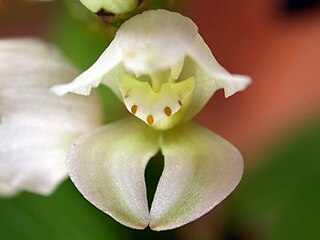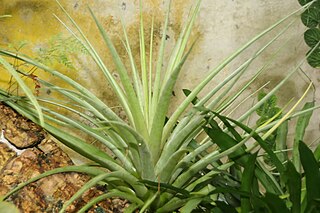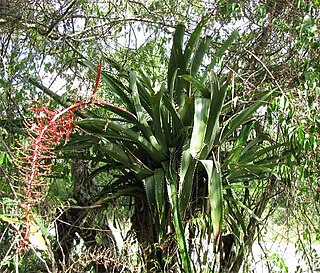
Aechmea nudicaulis is a bromeliad species in the genus Aechmea, which is often used as an ornamental plant. This species is native to Central America, the West Indies, central and southern Mexico, and northern and central South America.

Hypoxis decumbens is a species of plant in the Hypoxidaceae, considered by some authors to be included within the Liliaceae or Amaryllidaceae. The species is widespread across South America, Central America, Mexico, and the West Indies.

Eulophia alta is a species of orchid, known as the wild coco. It is widespread across tropical and subtropical parts of Africa, South America, Central America, Mexico and the West Indies, as well as the southeastern United States.

Govenia utriculata is a species of orchid. It is widespread across much of Latin America and the West Indies, from Mexico and Puerto Rico south to Argentina.

Tillandsia balbisiana, common name northern needleleaf, is a species of bromeliad in the genus Tillandsia. This species in native to Mexico, Central America, Colombia, Venezuela, the West Indies, and Florida.

Tillandsia capitata is a species of flowering plant in the family Bromeliaceae. It is native to Mexico, Honduras, Cuba and the Dominican Republic.

Tillandsia brachycaulos is a species of flowering plant in the genus Tillandsia. It is native to Mexico, Central America, and Venezuela.

Aechmea aquilega is a plant species in the genus Aechmea. This species is native to Brazil, Venezuela, the Guianas, Trinidad, Jamaica and Costa Rica.

Guzmania monostachia is an epiphytic species in the genus Guzmania. Also known as a West Indian tufted airplant, this species is native to South America, Central America, the West Indies and Florida. The species is also reportedly naturalized in Hawaii.

Tillandsia polystachia is a species of flowering plant in the genus Tillandsia. This species is native to Central America, the West Indies, Bolivia, Colombia, Brazil, Ecuador, Mexico and Venezuela.

Aechmea bracteata is a plant species in the genus Aechmea. This species is native to Central America, Mexico, Colombia, and Venezuela; it is also reportedly naturalized in the Bahamas.

Catopsis nitida is a species in the genus Catopsis. This species is native to southern Mexico, Central America, Cuba, Hispaniola, Jamaica and Puerto Rico.
Catopsis nutans is a species in the genus Catopsis. This species is native to Florida, Central America, Greater Antilles, Venezuela, Colombia, Bolivia, and Ecuador.
Tillandsia festucoides, commonly known as the fescue airplant, is a species of bromeliad that is native to the Greater Antilles, Mexico, the Cayman Islands, and Central America.

Catopsis floribunda is a species in the genus Catopsis. This species is native to the West Indies, Venezuela, Honduras, Oaxaca, and Florida.

Tillandsia fendleri is a species of flowering plant in the family Bromeliaceae. It is epiphytic. This species is native to the West Indies and South America.

Cyclopogon elatus is a species of terrestrial orchids. It is widespread across much of Latin America from Mexico and Belize to Argentina, as well as in the West Indies and southern Florida.
Cyclopogon cranichoides is a terrestrial species of orchid. It is found across much of the West Indies as well as in Central America, northwestern South America and Florida.

Habenaria floribunda is a species of orchid which is widespread across much of Latin America, the West Indies and Florida.

Habenaria distans, the hammock bog orchid, is a species of orchid. It is native to Latin America from Mexico to Argentina, as well as Florida, the Greater Antilles, and the Galápagos.

















